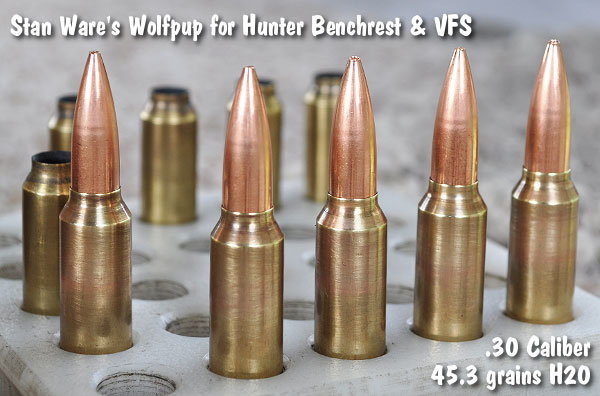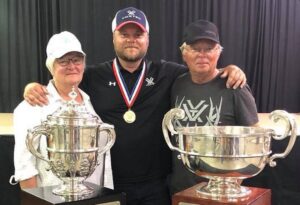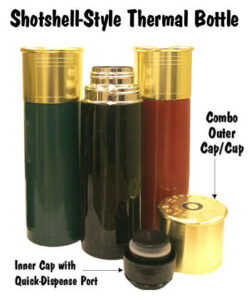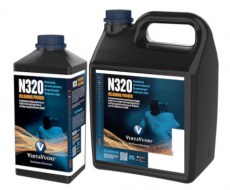Do you think that a long case neck is necessary for accuracy? Think again. Stan Ware’s radical Wolfpup cartridge broke all the rules, proving that a cartridge with a nearly no-neck design could deliver match-winning precision. Learn how the Wolfpup cartridge works. Retired gunsmith Stan Ware, a talented shooter, is not afraid to “think outside the box”. Stan competes both in the Hunter Benchrest (HBR), and Varmint for Score disciplines (VFS). Stan’s quest to create the ultimate Hunter Benchrest round led him to create the “Wolfpup”, a wildcat based on the 6mmBR parent casing. Stan was intrigued by the dominance 30 BRs have in VFS matches and wondered if a 30 BR stretched could be used in HBR competition. The case capacity was the challenge. HBR rules require that the cartridge hold at least 45.0 grain of water. This is the same as the capacity of a classic 30/30 case. Stan decided that he had to increase the volume of a 30-BR case by a significant amount to meet the HBR case requirements. To do this, he moved the shoulder forward a great deal. He achieved this by reaming a 30 BR reamer ever deeper while firing brass as he went. After three reamer runs, he had the capacity he required (the Wolfpup can hold 45.3 grains). He was amazed when he saw the finished product, a case that had almost no neck. From Trashbin To Winner’s CircleStan thought that Ware’s prototype Wolfpup cartridge was “dead upon arrival” because it had a short neck, unlike any “normal “cartridge. Stan told us, “I said this ain’t gonna work’ and threw the brass into the trash can. Honest. Stan did not have a seating die. He realized that the short neck created a little tension after firing-forming. So he seated some bullets – BIB 118s & 125s – with his fingers. He used H4198 powder and started at 35 grains. This is one grain more than a 30-BR load. Stan did a pressure test: “I went up to 41.0 grain and didn’t get a sticky bolt.” I settled on 37.9 grains Hodgdon 4198, which gave me 3150 fps. (Later testing revealed that 36.4 grains H4198 produced a second accuracy zone at around 3020 fps. Stan’s radical, short-necked Wolfpup fired great right out of the box. Once he found his velocity node, Stan’s radical short-necked Wolfpup shot great with both 7 and 10-ogive bullets in both 118s & 125s. The Wolfpup is easy to tune. It’s not fussy at all. It’s a winner. Stan started shooting the Wolfpup for VFS and HBR in 2006, and the ‘Pup” won matches almost immediately. Stan won the Wisconsin State VFS Championship in 2007 using the Wolfpup. Stan won the Grand Agg at a Webster City VFS match in June 2010, and also posted the highest X-Count of the match. He placed first at 100 yards, and second at 200. What a great cartridge! It almost ended up in a trash bin. Stan, do you deserve an award for the “most innovative benchrest-style cartridge design”? Stan laughs at the idea: “I am not a hero or a genius.” I didn’t really do anything. For me, the fun part is to think outside of the box. Shooting is a long-established process of experimentation. “You never learn everything.” Why Does It Works?
How can a case with such a radical design perform so well. Stan acknowledged that it was a good question. Stan explained: “The 30 BR was inherently accurate so I figured that something based on it should also be accurate. My personal belief says that the short neck does not hurt you. If the throat is straight in the barrel, the bullet will self-align. If the chamber is in good condition, the bullet will center itself in the throat. There’s not enough room in a regular case to do this, so the bullet may start off-center. You won’t get the same result every time. The stiffer neck of a conventional case prevents a bullet from self-centering, especially in a BR gun with a tight clearance.
Stan’s Wolfpup has a neck diameter of 0.330″. He turns his necks to load a 0.327″ round. Bullets are jammed about.020″ forward of the first contact with lands. When he closes his bolt, it pushes back the bullet in the case – almost like a soft seat. Stan says: “I normally bump the shoulder by.0005 to.001” so that they go in easily. Just by doing this, I get a little tension in the neck. I also use a bushing. Right now, I’m using a.322, which is not very sensitive. I’ve tried.325 bushings in one-thousandth increments and couldn’t really tell the difference. Stan uses a Wilson 30BR seater die, into which he ran a chamber reamer. This ensures a perfect fit of the case during seating operations. The Illustrated Gunstock
Stan’s stock includes scenes from Vietnam, along with a quotation. Here’s the story. Stan, a Vietnam combat veteran served “in-country” from 1965-1966 with the Army’s Non-Divisional Combat Unit (509th Non-Divisional Combat Unit) (out of Fort Riley). Stan visited a shop shortly before leaving Vietnam to have a souvenir lighter personalized. He asked the vendor to engrave a suitable inscription. The metal-worker at the shop engraved “War is tragedy.” Susan, Stan’s talented wife, hand-painted the message and combat scenes on Stan’s gun. She spent over 20 hours painting the stock of the rifle. Photos courtesy of Stan Ware and Ryan Ware.

















